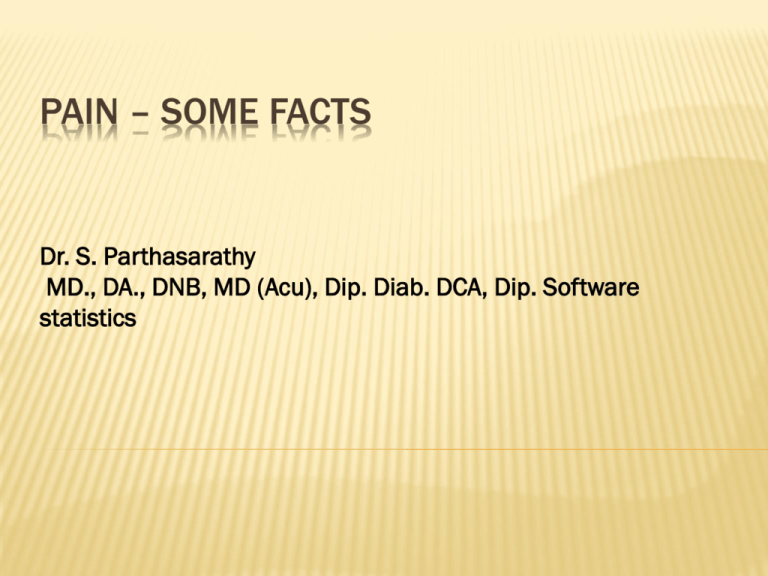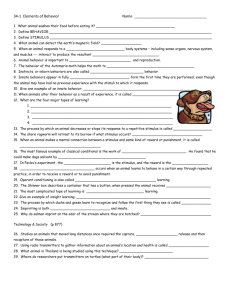2 MB - pain - the basics
advertisement

PAIN – SOME FACTS Dr. S. Parthasarathy MD., DA., DNB, MD (Acu), Dip. Diab. DCA, Dip. Software statistics DEFINITION An unpleasant sensory and emotional experience associated with actual or potential tissue damage, or described in terms of such damage. ISSP definition SOME SAY AS An unpleasant sensation, occurring in varying degrees of severity as a consequence of injury, disease, or emotional disorder. pain always has a subjective component MARGO MCCAFFREY Whatever the patient says hurts. WHAT IS NOCICEPTION ?? Nociception is the activation of a nociceptor by a potentially tissue-damaging (noxious) stimulus. It is the first step in the pain pathway WHAT IS A NOCICEPTOR ?? nociceptor is a specialized, neurologic receptor that is capable of differentiating between innocuous and noxious stimuli Terminals of A delta and C fibres ANALGESIA Patient has no pain But the noxious stimulus is there Anaesthesia – all sensory modalities gone While analgesia – only pain PARAESTHESIA Abnormal sensation Spontaneous or evoked Painful or painless Painful paraesthesia is dysaesthesia Formication is a form of paresthesia in which the patient feels as though bugs are crawling ANAESTHESIA DOLOROSA pain is felt in an area that is otherwise numb or desensitized Trigeminal neuralgia Trigeminal nerve is ablated no sensation but suddenly shooting pain comes HYPERPATHIA hyperpathia refers to an abnormally intense pain response to repetitive stimuli. Usually hyperpathic area of skin is not sensitive to a simple stimulus but over responds to multiple stimuli Pin prick ALGOGENS Histamines, substance P, potassium, and prostaglandins, bradykinin, 5 HT are examples of algogenic substances Produced or injected – nociception HYPERALGESIASHIFT OF THE STIMULUS PAIN RESPONSE CURVE TO THE LEFT P A I n stimulus Primary Pain to a non noxious stimulus in the area of injury Pharyngitis – swallowing – painful Secondary Pain to a non noxious stimulus in the area by the side or encircling the injury PRIMARY Starts within minutes Area of injury Sensitive to heat and mechanical Peripheral sensitization SECONDARY Delayed onset Wider area Only thermal Central role PRIMARY HYPERALGESIA – MECHANISMS Expansion of receptive field of nociceptor Sensitization of nociceptor Loss of central inhibition Increased CAMP levels Activation of protein kinase C SECONDARY HYPERALGESIA Antidromic release of algogens Dorsal horn neurons – sensitive WDR neurons – plastic changes Sometimes irreversible Post op pain - !!! SENSITIZATION shift of the stimulus - nerve fibre response curve to the left F I B r e s stimulus SENSITIZATION Sensitization is a state in which a peripheral receptor or a central neuron either responds to stimuli in a more intense fashion than it would under baseline conditions or responds to a stimulus to which it is normally insensitive. Sensitization occurs both at the level of the nociceptor in the periphery and at the level of the second-order neuron in the spinal cord CLASSIFY PAIN TYPES OF PAIN Nociceptive Somatic Visceral Nonnociceptive Peripheral Central Psychogenic NOCICEPTIVE – SOMATIC Dull or sharp Localized Increased with movement Eg. Tooth ache SKIN, MUSCLE, BONE, JOINT ETC…. VISCERAL NOCICEPTION autonomic sensations including nausea, vomiting, and diaphoresis. There are often cutaneous referral sites NEUROPATHIC burning, electrical, and numbing Intervening normal Sudden Post herpetic, trigeminal, glossopharyngeal CENTRAL PAIN Central pain syndrome is a neurological condition caused by damage or malfunction in the Central Nervous System (CNS) which causes a sensitization of the pain system. Trauma, tumors, stroke, Multiple Sclerosis, Parkinson's disease, or epilepsy . Pain can either be relegated to a specific part of the body or affect the body as a whole. DEJERINE ROUSSY SYNDROME severe, persistent, paroxysmal, often intolerable, pains on the hemiplegic side, not yielding to any analgesic treatment THEORIES HAVE BEEN PROPOSEDNEUROPATHIC PAIN that state there are specific cellular and molecular changes that affect membrane excitability and induce new gene expression after nerve injury, thereby allowing for enhanced responses to future stimulation. the ectopic impulses of neuroma, changes of sodium and calcium channels in injured nerves, sympathetic activation, and deficient central inhibitory pathway contribute to the mechanisms of neuropathic pain PSYCHOGENIC PAIN Psychogenic pain, also called psychalgia, is pain that is caused by increased, or prolonged by mental, emotional, or behavioural factors Headache, back pain, or stomach pain are some of the most common types of psychogenic pain. It accompanies or induced by social rejection, broken heart, grief, love sickness, or other such emotional events. PSYCHOGENIC PAIN No nociception No neuropathic mechanism But some evidence of psychologic symptoms to meet criteria for somatoform pain disorder, depression, Usually chronic WHY DO WE NEED TO CLASSIFY PAIN ?? Origin of pain Treatment modalities Prognosis TEMPORAL CLASSIFICATION Acute Acute pain is temporally related to injury and resolves during the appropriate healing period Chronic pain that persists for more than 3 months or that outlasts theusual healing process. Recurrent Duodenal ulcer OTHER CLASSIFICATIONS Etiology Arthritic Cancer Site Appendix Mastitits HISTORY AND THEORY Aristotle believed that pain was due to evil spirits entering the body through injury, Hippocrates believed that it was due to an imbalance in vital fluids. it was thought that pain originated outside the body, perhaps as a punishment from God In 1644, René Descartes theorized that pain was a disturbance that passed down along nerve fibers until the disturbance reached the brain THEORIES OF PAIN - SPECIFICITY THEORY body has a separate sensory system for perceiving pain just as it does for hearing and vision— Von Frey (1895) and this system contains its own special receptors for detecting pain stimuli, its own peripheral nerves and pathway to the brain, and its own area of the brain for processing pain signals SPECIFICITY THEORY when someone pulls the rope to ring the bell, the bell rings in the tower. Proved not correct PATTERN THEORY- GOLDSCHNEIDER (1920) there is no separate system for perceiving pain, receptors for pain are shared with other senses, such as of touch. people feel pain when certain patterns of neural activity occur. OTHER THEORIES Wilhelm Erb's (1874) "intensive" theory, that a pain signal can be generated by intense enough stimulation of any sensory receptor, has been soundly disproved Central processing theory Inputs – same but the central processing differs to produce pain MELZACK WALL GATE CONTROL THEORY pain stimulation is carried by small, slow fibers that enter the dorsal horn of the spinal cordWall highlighted that pain messages are carried by the specific nerve fibres that can be blocked before reaching the brain by the actions of other nerves and psychological factors THE GATE OPENS AND CLOSES THE GATE CONTROL THEORY The gate control theory states that non painful stimulus such as distraction competes with the painful impulse to reach the brain. This rivlary limits the number of impulses that can be transmitted in the brain by creating the hypothetical gate Distraction – mechanical , endorphins, psychological Only theory – multifaceted pain approach THE IDEA IS if the large fibers remain un stimulated, the pain signal will be propagated, but if they are activated, they act as an electrical gate, blocking the transmission of pain up the C fiber. How is pain perceived ?? TYPES OF FIBRES MYELIN – DIA MM VELOCITY MM/S Aα Proprio, somatic Motor yes 12–20 Aβ Touch, pressure yes 5–12 Aγ Motor muscle spindle Yes 3–6 Aδ Pain, cold, touch Yes 2–5 B Preganglionic autonomic Yes 3 C Pain, temperature,No 0.4–1.2 70–120 30–70 15–30 12–30 3–15 0.5–2 PAIN STARTS Pain receptors (nociceptors) The sensation of pain then travels from the periphery to the spinal cord along A-delta and C fibers Lissauer’s tract synapse on second order neurons in substantia gelatinosa in dorsal horn (second order neuron) Spino thalamic tract (Neo and paleo) crossing via the anterior white commissure before ascending contralaterally. Before reaching the brain, the spinothalamic tract splits into lateral neospinothalamic tract and medial paleospinothalamic tract Neo - posterolateral nucleus of the thalamus Paleo spinothalamic neurons carry information from C fibers and terminate throughout the brain stem, a tenth of them in the thalamus and the rest in the medulla, pons and periaqueductal grey matter OTHER SECOND ORDER NEURONS Spino mesencephalic Midbrain – behavioural responses to pain Spino reticular Alerting and arousal motivational aspects -pain Pontine and medullary reticular formation Third order neurons from thalamus to cortex anterior cingulate cortex (emotional aspect ) Somatosensory cortex SIMPLE NEUROANATOMY OF PAIN DESCENDING INFLUENCE DESCENDING INFLUENCE In 1858 Bernard found that spinal afferents can be modified by supraspinally organized systems. Three and three Brain ,thalamus and brainstem PAG, LC, NRM Serotonin , noradrenaline and opioids Additional GABA , glutamate and acetyl choline COX ET AL Medial forebrain Lateral hypothalamus Electrical stimulation attenuated foot pain ESSENTIAL NUCLEI Periaqueductal grey PAG – extensive connections Opioids NUCLEUS LOCUS CERULEUS Pons Projection to hippocampus ,spinal cord and cortex Noradrenergic system NUCLEUS RAPHE MAGNUS Medulla Serotonin – originally But now multiple , glutamate and opioids PAIN FACTS – SUMMARY DEFINITION CLASSIFICATION THEORIES PATHWAYS DESCENDING CONTROL OH !! PAINFUL LECTURE ENDS ?? Thank you all





